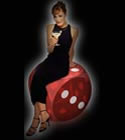Category No. 11: There low cards to an eight.
This holding is not playable unless it has straight possibilities or includes an ace.
Then it plays well only if it is the sole low hand working or if you are heads up against a probable weak hand.
Category No.12: Three flushes.
Since a lot of pots are split and it is though to make a flush, for your three flush to be playable, you have to be in a multiway pot with several hands against you that look as though they are going high, or your must have two low cards. Also, your flush cards need to be extremely live.
In other words, discard most of your three flushes if there are two of your suit out. One of your suit on board is OK if you have a hand like and it is cheap to enter the pot. But if several low cards are showing strength, throw these hands away.



If you should catch high cards on the later streets, you will be in a situation where players will know that you are going for a flush or a high hand, and you will get jammed in by a high hands and a low hand. In short, you must make your flush quickly to survive this kind of situation.
Summing up, three flushes tend to do poorly in stud eight-or-better unless you have two low cards, and then your hand must be very live.
Also, when you hold two low flush cards, it is always best to have one of them up so you are disguised as a low hand and perhaps can drive out a low hand later in the deal.
Should make both a flush draw and a low draw, you might be able to knock out the low hand and play only against the high hand or to knock out the high hand, just play against the low hand, and win the high half with almost nothing.
Category No.13: Higher three straights. These hands do very poorly, but there are a few people who play them.
When you are against these players, they are not as likely to have a high pair when they show a high card. Moreover, when higher three straights develop, they turn into strong and jamming type hands.
Category No.14: Small pairs with a medium or large kicker. You should not play small pairs with a medium or large kicker unless most everyone has gone out, you are in a steal position, and you have a good chance to pick up the antes and bring-in.
Category No.15: Medium high straights. Hands such as should just about never be played unless you are heads up against a weaker high hand or in certain situations where your cards are completely live, you are against several weak players, and no one has raised or is likely to raise.



and



However, in general, these are trash hands and should be thrown away. Notice that even if two of your cards are straights flush cards as in the second example these hands still should be discarded.
Medium high straight draws against multiple low hands to even worse. Your opponents will know that you are going high and can several punish you, plus many times you don’t even make a pair to have a chance for the high end.
Final note: Even though the information provided is accurate, it is not absolute, since many Starting Hands are close to each other in value. The situation you find yourself in is often more important than the specific hand you are holding.
Because a lot of hands run very close – such as the best high hand against a quality low hand – it is important to fully assess the situation before deciding on the strength of your starting hand.
Some of these rankings can change dramatically depending on the particular three cards that you are holding and on the exact number of opponents that you are against.
In addition, it is very important to be playing the best hand, and not the second-best hand. In high-only seven card stud, you often can play the second-best hand, such as a small pair with an overcard kicker, and chase.
Second-best hands do very poorly in this game, partly because you frequently do not know where you stand even when you improve. This is especially true in a multiway pot, as a lot of concealed hands – like trips, straights, and flushes – will appear on the river.
Finally, how to play your starting hand may not always be clear – that is, should you raise or just call? In general, you raise on third street only if you have a hand that plays better heads up, or if you have a hand that is very strong and several people are already in.
if you have a typical playable three-card low and many players remain to act, you probably should just “limp in”, ; if other players already have called, you should call also. If there has been a raise in front of you, you generally, should still call, but you usually should not call a double raise.
The exception to just calling is when you are first in from a late position. Now you should raise, because you have the added equity of possibly being able to steal the antes.
Introduction / Starting Hands / Three of a Kind Wired / Disguising Your Hand / Ante Stealing / Getting Reraised on a Semi-Steal / When an Ace Raises / When the Bring – In Raises / Afterthought


